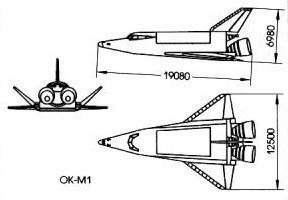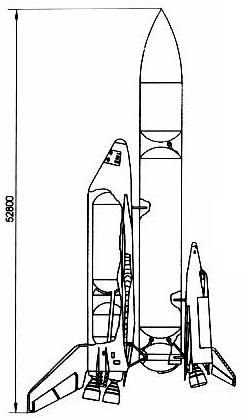
Home - Search - Browse - Alphabetic Index: 0- 1- 2- 3- 4- 5- 6- 7- 8- 9
A- B- C- D- E- F- G- H- I- J- K- L- M- N- O- P- Q- R- S- T- U- V- W- X- Y- Z
OK-M1
 OKM-1 Spaceplane |
AKA: Oryol V3. Status: Study 1984. Payload: 7,200 kg (15,800 lb). Thrust: 39.20 kN (8,813 lbf). Gross mass: 31,800 kg (70,100 lb). Unfuelled mass: 29,300 kg (64,500 lb). Height: 19.08 m (62.59 ft). Span: 12.50 m (41.00 ft).
This consisted of three components arranged in parallel: an RVK unmanned booster stage derived from the Buran spaceplane; a PTO expendable external propellant tank; and the OK-M1. Six dual-thrust tri-propellant engines operated at lift-off: four mounted in the RVK and two in the OK-M1. These burned liquid oxygen and Sintin (synthetic kerosene) at lift-off, transitioning to liquid oxygen and hydrogen at higher altitudes.
Within what would normally be the payload bay and crew cabin of the RVK spaceframe were Sintin and liquid oxygen tanks. The PTO external tank carried only liquid oxygen and liquid hydrogen. After depletion of its propellants the RVK separated and glided back to a landing at Baikonur. The PTO/OK-M1 continued on into orbit, where the external tank was jettisoned. Total mass of the MMKS was 800 metric tons at lift-off.
The crew of the OK-M1 were equipped with ejection seats. Saving the crew in the event of a launch vehicle failure was a complex problem. Special safety suits allowing crew ejection, even in the fireball of a booster explosion. The OK-M1 itself had a unique shape, a blend of the Buran and the 'Lapot' lifting body shape of Spiral. The result was a straight delta wings joined to a broad fuselage with an upturned nose. The OK-M1 used liquid oxygen and kerosene both as orbital maneuvering system propellants and to operate three 7 kW generators for electrical power. These were supplemented with lithium batteries. The two power buses together could provide up to 60 kW of power at 270 V.
Two 2000 kgf main engines were supplemented by a reaction control system of 10 x 40 kgf and 8 x 2.5 kgf thrusters. Normal crew was four. Up to four additional passengers could be transported if required in a special module in the cargo bay. Landing mass of the OK-M1 without payload was 22,400 kg. With a crew of four the OK-M1 could deliver 7200 kg of payload to a 250 km orbit. Payload delivered to a 450 km space station orbit was 5000 kg. Maximum payload that could be returned to earth was 4200 kg. The cargo bay was 3.0 m diameter x 6.5 m long, with a total volume of 40 cubic meters.
The OK-M1 / MMKS, with its new tri-propellant engines and RVK flyback booster, would be costly to develop. However Lozino-Lozinskiy was more interested in applying the same propulsion systems and orbiter to his MAKS air-launched system.
Crew Size: 8.
Family: Space station orbit, Spaceplane. Country: Russia. Propellants: N2O4/UDMH. Agency: Molniya bureau. Bibliography: 89.
 | OKM-1 Booster |
Back to top of page
Home - Search - Browse - Alphabetic Index: 0- 1- 2- 3- 4- 5- 6- 7- 8- 9
A- B- C- D- E- F- G- H- I- J- K- L- M- N- O- P- Q- R- S- T- U- V- W- X- Y- Z
© 1997-2019 Mark Wade - Contact
© / Conditions for Use